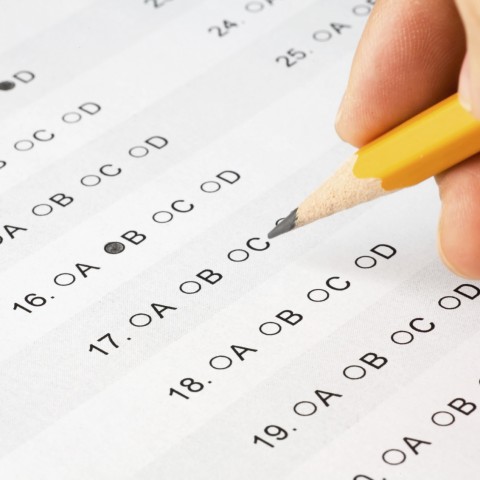
Learning languages starts from lessons in the classroom to traveling, working and living, or learning from the cultures of the country. No matter what strategy of learning, most people find studying from the basics plays an important role in building a sustainable foundation.
When I first studied English, I was also adopting common classroom phrases to understand teachers’ commands. Most of them are actually quite helpful in my actual classes where I later on became a teacher.
If you’re a student learning Vietnamese language, you’re going back to school, or you’re new here and want to improve Vietnamese language learning, I’m here for you. I’m going to share with you several lists of lexicon and Vietnamese classroom words and phrases that you will absolutely use at some point.
First, let’s discover the Vietnamese education system through vocabulary about schools.
 Table of Contents
Table of Contents
- School vocabulary (Từ vựng về trường học)
- School departments Vocabulary (Từ vựng về các phòng ban trong trường)
- Vocabulary about positions in a school (Từ vựng về các vị trí trong trường học)
- Classroom Greetings (Chào hỏi trong lớp)
- Instructions from Teachers
- Teacher’s common teaching techniques
- Student’s common questions/requests
- Explain Absence and Tardiness
- Common questions for students
1. School vocabulary (Từ vựng về trường học)

The Vietnamese education system is not very complicated since we only have a few typical levels of learning and it’s consistent across the country. Public schools’ tuition fees are often more affordable than international or private schools. Here are the most particular school types in Vietnam that you might have heard of to learn vietnamese language.
- Trường dân lập (Private school) : Private schools teaching quality is often slightly lower than public schools due to high costs but low investment and support from the government. However, some families prefer sending their children to private schools for their suitable locations or lower student numbers.
- Trường công lập (Public school) : Public schools are often the most sought after because of their moderate tuition fees and guaranteed teaching quality.
- Trường quốc tế (International school) : There are not many international schools in Vietnam because of the high cost but entering might be easier because it’s for people who can afford the tuition fee.
- Nhà trẻ (Daycare/ Child care center) : Nhà trẻ is for kids between 1-2 years old, some even accept kids from 6-9 months old. Most of them are private establishments because official schools start from preschool which is for kids from 3-5 years old. For some families who don’t have anyone to take care of young kids, they would prefer sending them to local daycares during working hours.
- Trường mầm non/trường mẫu giáo (Preschool) : Trường mẫu giáo accepts students from 3 to 5 years old. Most of the lessons contain games, sing and dance activities and learning numbers or alphabets to prepare for primary school.
- Trường tiểu học/Trường cấp 1 (Elementary school) : Elementary schools are for students from 6 – 10 years old which means there are 5 grades, from grade 1 to grade 5. Most elementary schools don’t require entrance tests but depending on the admissions target of each school, students on the right line will be given priority to enroll first.
- Trường Trung học phổ thông/Trường cấp 2 (Middle school/ Secondary school) : Middle school/ Secondary schools are for students from 11 to 14 years old. They are from grade 6 to 9. Similar to elementary school, entrance tests are not required but study results from elementary school will be considered.
- Trường Trung học cơ sở/Trường cấp 3 (High school) : High school is the most important level of every student because it prepares for university and therefore, specialized schools often require students to take an entrance test. Regular schools may not do so but it takes a lot of effort for parents to choose the right school for their children due to the high demands every year.
- Trường đại học (College/ University) : A bachelor degree is very important to anyone when looking for a job in Vietnam and therefore, entering college/ university is the highest target set for students after 12 years studying at school. The high school graduation exam is used to determine the score for university admission, so this exam is considered extremely important for every student. College/ University usually takes 4 years for general subjects and 5 to 6 years or even more for majors such as medicine and pharmacy.
- Trường cao đẳng (Undergraduate) : If university entrance requirements are often high, undergraduate in Vietnam are a little bit easier to enroll because of lower standards. Undergraduate usually takes 2-3 years.
- Tại chức (Service education/ Service learning) : Service education/ service learning schools are at a lower level than undergraduate or university. It often requires at least 2 years to finish but the degree is not very valuable.
2. School departments Vocabulary (Từ vựng về các phòng ban trong trường)
Technically, these departments are the most common ones in every school in Vietnam. Depending on the specialized disciplines, the departments may differ. Let’s take a look at some vocabulary about school departments in order to prepare for the useful classroom phrases for students and teachers in Vietnamese that I’m going to share with you in the upcoming parts.
- Phòng Học thuật/Phòng Học vụ (Academic Department)
- Phòng Hiệu trưởng (Principal’s office)
- Phòng Hiệu phó (Vice-Principal’s office)
- Phòng y tế ( Nurse’s office)
- Phòng truyền thống (Hall of Fame)
- Văn phòng Đoàn (The youth union room)
- Phòng thí nghiệm (Laboratory)
- Thư viện (Library)
- Giảng đường (Lecture hall)
- Ký túc xá (Hall of resident)
- Phòng bảo vệ (Security section)
- Khu vực gửi xe (Parking space)
- Căng tin (Cafeteria)
- Sân chơi (Playground)

If you’re new to a school and want to ask for directions, here is the sentence structure.
- To friends :
Bạn ơi, làm ơn cho mình hỏi + place + ở đâu? (Hey, may I ask where the + place + is please?)
- To more senior people:
Anh/chị ơi, làm ơn cho em hỏi + place + ở đâu? (Hey, may I ask where the + place + is please?)
- To teachers (if you think they are)
Thưa thầy/cô, làm ơn cho em hỏi + place + ở đâu ạ? (Hey, may I ask where the + place + is please?)
For examples :
- Bạn ơi, làm ơn cho mình hỏi phòng y tế ở đâu? (May I ask where the nurse’s office is please?)
- Chị ơi, làm ơn cho em hỏi thư viện ở đâu? (May I ask where the library is please?)
- Thưa cô, làm ơn cho em hỏi phòng truyền thống ở đâu ạ? (May I ask where the hall of fame is please?)
3. Vocabulary about positions in a school (Từ vựng về các vị trí trong trường học)
Beside your classmates, there will be some positions that you must know when studying at school, for instance:
- Giáo viên (Teacher)
- Giảng viên (Lecturer)
- Trợ giảng (Teaching assistant)
- Giáo viên chủ nhiệm (Head teacher)
- Hiệu phó (Vice-principal)
- Hiệu trưởng (Principal)
- Giáo viên bộ môn (Subject teacher)
- Học sinh (Pupil)
- Sinh viên (Student)
- Bí thư (Secretary)
- Lớp trưởng (Monitor)
- Lớp phó (Vice monitor)
- Bảo vệ (Guard)
- Tạp vụ/Lao công (Janitor)
- Giám thị (Supervisor)
- Nhân viên y tế (Medical officer)
To introduce someone, you can say:
- – Đây là lớp trưởng của lớp tôi (This is my class monitor)
– Kia là giáo viên chủ nhiệm của tôi (That is my head teacher)

4. Classroom Greetings (Chào hỏi trong lớp)
Moving to the main part of the lesson, you wil see that most sentences can be use in Vietnamese reading and writing also. First, let’s explore several basic Vietnamese words and phrases for greeting at school.
- First, let’s see how students greet teachers in Vietnam.
- ➜ Em chào thầy (Hello teacher – For male teacher)
➜ Em chào cô (Hello teacher – For female teacher)
➜ Em chào các thầy ((Hello teacher – For male teachers)
➜ Em chào các cô (Hello teacher – For female teachers)
- ➜ Con chào thầy (Hello teacher – For male teacher)
➜ Con chào cô (Hello teacher – For female teacher)
➜ Con chào các thầy ((Hello teacher – For male teachers)
➜ Con chào các cô (Hello teacher – For female teachers)
Why using this : it sounds closer
Note : it’s more common for young students such as preschoolers or primary students.
- Next, here are ways for teachers to respond to students.
- ➜ Chào em (For old student)
➜ Chào con (For preschooler)
➜ Chào các em (For old students)
➜ Chào các con (For young students)
➜ Cô/Thầy chào các con (For students in general)
➜ Cô/Thầy chào các em (For students in general)
➜ Tôi chào các em (More formal)
- To know how students greet each other, take a look at our video on our Youtube channel How to say Hello or our free article lesson How to say Hello for more details.
5. Instructions from Teachers
You must have noticed somewhere that you can either use “Các em” or “Cả lớp” as “you all” when giving imperatives. In any classroom in the world, there will be different instructions or requirements from teachers for each class. If you are teaching, here are the easiest and most common Vietnamese classroom phrases for teachers that you can use on a daily basis:
- ➜ Các em mở sách trang … (Open your book to page…)
➜ Các em trật tự (Be quiet)
➜ Cả lớp tập trung (Focus)
➜ Bây giờ cô sẽ kiểm tra bài cũ (I’m gonna check the previous lesson now)
➜ Bạn nào chưa làm bài giơ tay (Who hasn’t done your homework please raise your hand)
➜ Hết giờ, cả lớp nộp bài (Time’s up, please submit your assignments)
➜ Hôm nay chúng ta sẽ học về (Today, we’re going to learn …)
➜ Bây giờ chúng ta sẽ làm bài theo nhóm (Now we will work in group)
➜ Cả lớp làm bài tập số ... (Do the exercise number …)
6. Teacher’s common teaching techniques
In some cases, there are some questions to check students’ understanding in a test or at the end of the lesson, or useful classroom phrases in Vietnamese that teachers can apply as teaching techniques.
- To check understanding
- ➜ Câu này là đúng hay sai? (This is correct or incorrect?)
➜ Có ai có câu hỏi gì không? (Does anyone have any questions?)
➜ Các bạn đã nghe rõ đề bài chưa? (Have you heard the title clearly?)
➜ Các bạn đã hiểu rõ đề bài chưa? (Have you understood the title clearly?)
- Correction techniques
- ➜ Có bạn nào có câu trả lời không? (Does anyone have the answers?)
➜ Có bạn nào có đáp án khác không? (Does anyone have another answer?)
➜ Em có chắc không? (Are you sure?)
➜ Có bạn nào có thể giúp bạn được không? (Can anyone help your friend?)
➜ Đây có phải đáp án cuối cùng của em không? (Is this your finalanswer?)
7. Student’s common questions/requests
Education 4.0 encourages students to interact with teachers and their peers anytime in the class for more effectiveness. With teachers who are well trained and equipped with 4.0 teaching methodologies, allowing students to have some free talks in the class is essential to keep students engaged.
Therefore, there are various Vietnamese classroom phrases for students in the classroom:
- For entering the classroom:
- ➜ Thưa cô, cho con vào lớp ạ (Teacher, may I come in the class please?)
➜ Thưa cô, cho em vào lớp ạ (Teacher, may I come in the class please?)
- For better clarity:
- ➜ Thưa cô, con chưa nghe rõ ạ (Teacher, I haven’t heard clearly)
➜ Con có thắc mắc ạ (I have a question)
➜ Em có câu hỏi ạ (I have a question)
➜ Em chưa rõ phần này ạ (I’m not sure about this part yet)
➜ Cô có thể giải thích phần này không ạ? (Can you explain this part?)
➜ Cô có thể nói lại phần này không ạ? (Can you repeat this part?)
➜ Cô chữa bài này được không ạ? (Can you correct this exercise?)

- For adding ideas/comments
- ➜ Con có ý kiến ạ (I have a comment)
➜ Em muốn bổ sung thêm (I’d like to add in some idea)
- For leaving the classroom
- ➜ Thưa cô, cho con ra ngoài ạ (Teacher, may I go out please?)
➜ Thưa cô, đến giờ nghỉ rồi ạ (Teachers, it’s break time)
8. Explain Absence and Tardiness

Everyone would be late or play hooky once in their lives. I’m not an exception.
Let me spill the beans. It was in my highschool. My parents and other students’ were asked to meet my head teacher because the whole class skipped school to hang out the day before.
I had a really good relationship with a fabric shop owner who I’m her regular customer at that time. Because of the parents meeting, I asked her to play as my mom and go meet my teacher.
She agreed!
The day later, she went to my school, acting really cool and apologizing to my teacher as other parents would do. I couldn’t thank her enough.
Break time is over. Let’s get back to the lesson and see what Vietnamese classroom phrases for students that can be used when explaining absence or tardiness.
- ➜ Thưa cô, con bị hỏng xe ạ (My bike is broken)
➜ Thưa cô, con ngủ quên ạ (I overslept)
➜ Thưa cô, hôm nay nhà con có việc, con xin phép nghỉ ạ (I have a family matter to attend today, I would like to take a day off)
➜ Thưa cô, hôm nay con thấy không được khoẻ ạ (I’m not feeling well today)
9. Common questions for students
Last but not least, before checking some useful classroom questions for students, let’s take a look at several words that you can use for the sentence structures afterwards.
- Cái bảng đen (Blackboard)
- Quyển sách (Book)
- Cái ghế tựa (Chair)
- Bàn học sinh (Desk)
- Cái bàn (Table)
- Khăn lau bảng (Duster)
- Cục tẩy (Eraser)
- Quả địa cầu (Globe)
- Sổ ghi chép (Notebook)
- Gọt bút chì (Pencil sharpener)
- Thước kẻ (Ruler)
- Cái bút (Pen)
- Bút chì (Pencil)
- Hộp bút (Pencil Case)
- Sách điện tử (Electric book)
Sentence structure
| Lend me a + thing For example : Mày ơi, cho tao mượn cái bút (Hey you, lend me a pen) |
For example:
- ➜ Cho tao mượn cục tẩy (Lend me an eraser)
- ➜ Cho tao mượn cái thước kẻ (Lend me a ruler)
Other questions:
- ➜ Mày làm bài tập về nhà chưa? (Have you done the homework?)
- ➜ Câu 2 là gì? (What’s the answer for number 2?)
- ➜ Đến nhanh lên, cô chuẩn bị điểm danh (Come quickly, teacher is about to check attendance)
- ➜ em>Mày không đi học à? (You’re not coming?)
- ➜ Mày đưa tao về được không? (Can you give me a ride?)
That’s pretty much for today and I hope it helps.
I’d like to share a little bit more about school etiquettes in another article in the near future.
Although English can be spoken if you’re lucky enough, knowing some basic Vietnamese phrases will help you be more engaged and interact with locals better.Thus, it’s alway worth it to surprise Vietnamese people or your teacher on Vietnamese Teachers’ Day.
For more FREE flashcards, vocabulary lists or audio files if you’re trying to learn Vietnamese language successfully, visit our website VietnamesePod101 and Youtube Channel Learn Vietnamese with VietnamesePod101.com. You can get your free lifetime account for real lessons by real teachers.
Bai!









